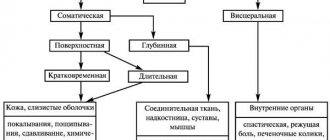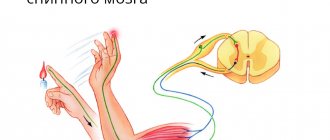Strong painkillers, or, as they are called in medicine, analgesics, are designed to identify and, most importantly, eliminate the causes of pain. Painkillers are divided into narcotic, which are addictive when used over a long period of time, and non-narcotic, which do not affect the central nervous system and are not addictive. In all the variety of analgesics, in a short review we will consider the most effective drugs and choose the most powerful pain reliever.
TheBiggest.ru strongly does not recommend self-medication! This can be life-threatening.
Before using any medications, consult your doctor.
What kind of pain is there?
Doctors divide pain into two main categories: acute and chronic.
Acute pain is not long-lasting, it occurs suddenly, usually due to easily diagnosed causes (for example, a burn of a finger, a broken bone, etc.).
Chronic pain – persists for a long period of time (months, years). It accompanies many diseases, such as rheumatism, cancer, osteoarthritis, etc.
Taking painkillers can blur or even completely hide the symptoms of a serious illness. For example, in case of acute pain in the abdomen or heart, you should never take painkillers - this is fraught with untimely or incorrect diagnosis, which can lead to dire consequences. Therefore, before taking the drug, it is imperative to consult your doctor.
Conclusions about pain pills
Determining which painkiller is best is difficult. This is due to the fact that effectiveness is determined not only by the composition and production technology, but also by the quality of raw materials and the standards of a particular pharmaceutical company. All this affects the speed of action of the drug and what types of pain it helps with.
The medications described in this article are relatively harmless and are widely available in Russian pharmacies. But before purchasing directly, you should analyze your condition and select a specific name in advance. Ideally, seek advice from a doctor.
How do painkillers work?
The mechanism of pain in general terms is as follows:
- In damaged tissues of the body, nerve endings transmit pain impulses to the brain.
- In the same place, special substances are released that irritate the nerve endings and increase discomfort.
- Also, under the influence of the nervous system, due to damage, muscle tissue contracts - a spasm occurs (if it is present).
Painkillers, depending on their class, can act at several levels:
- They inhibit the central nervous system, which relieves pain;
- Reduce the production of substances that irritate nerve endings;
- Relieving spasm of smooth muscles.
Narcotic analgesics
Let's start the rating with opioid, or narcotic painkillers. Potent painkillers of this group are used only in cases of acute and unbearable pain in patients.
1
Buprenorphine
A very strong painkiller in the form of a white crystalline powder, which is poorly soluble in water, and therefore alcohol solutions are used.
Quickly relieves pain after surgery. It is prescribed for operated oncology patients, patients after heart surgery and renal colic, as well as for severe burns.
Not recommended for use during pregnancy or traumatic brain injury. And also for people with a low threshold for physical dependence when using opioid medications.
2
Butorphanol
The white crystalline substance, easily soluble in water, is also an opioid pain reliever.
Easily relieves moderate and severe pain of various origins, and is actively used in postoperative rehabilitation.
It should be prescribed with caution, as it has many side effects; an overdose can put the patient into a coma, and the lethal dose is 50 mg/l.
What types of painkillers are there?
All painkillers are divided into two main groups:
Narcotic analgesics . These drugs directly affect the brain, inhibiting its activity. Their action is often accompanied by euphoria and has a sedative and hypnotic effect. They cause addiction, so this group of drugs is prescribed by a doctor and issued strictly according to the prescription.
Non-narcotic analgesics . A wide range of drugs that do not affect the central nervous system, do not cause addiction and other associated effects characteristic of narcotic analgesics. A large number of drugs in this group, in addition to pain relief, also have antipyretic and anti-inflammatory effects. They can be divided into the following groups:
- non-steroidal anti-inflammatory drugs: relieve pain, fever and inhibit inflammatory processes. Used for many diseases: colds, toothaches, connective tissue diseases, etc. Representatives - Nurofen, Aspirin, Ketanov;
- antispasmodics – relieve spasms of smooth muscle muscles. Representatives - Drotaverin, No-Shpa .
- combination drugs - include several groups of drugs that work in several directions (to relieve spasms, reduce fever and inflammation). Such drugs are, for example, Pentalgin, Caffetin, Trigan .
Analogues of painkillers
Let’s complete our review with a list of substitutes that are similar in composition and principle of action, but differ sharply in price from their expensive counterparts.
1
Ibuprofen
A non-steroidal anti-inflammatory drug based on propionic acid, it relieves pain well and also has antipyretic properties.
It was first synthesized in 1962 by Stuart Adams and John Nicholson. It perfectly reduces pain due to the large number of pharmacological drugs included in its composition.
It is a substitute for Nurofen, and is almost 5 times cheaper than its analogue.
2
Paracetamol
In Western countries, this drug is known under the name "Acetaminophen", and it is used to relieve pain and reduce fever.
The non-narcotic analgesic was introduced into medical practice at the end of the 19th century, and it quickly gained popularity as an inexpensive and very effective remedy.
It perfectly relieves pain and fever, and it is recommended to take it with plenty of liquid. Today this is perhaps the best remedy for relieving headaches.
3
Narcotic painkillers
Common narcotic painkillers include the following drugs:
- Morphine is an opium alkaloid. It has a strong analgesic effect and causes a state of euphoria. Depresses the respiratory center and has a negative effect on the cardiovascular system. When used, a state of dependence may develop - drug addiction. It is used to relieve acute pain in injuries, myocardial infarction, and cancer.
- Omnopon is a mixture of opium alkaloids, half of which are morphine. Has less analgesic properties. It is used for injuries, burns, pain associated with spasms (renal, hepatic colic). It also causes drug dependence;
- Codeine is similar in action to morphine, but its distinctive feature is the strong inhibition of the cough center of the brain, and therefore is used to relieve acute coughing attacks.
- Promedol has a weaker effect than morphine. Acts as an antispasmodic, often used in obstetric practice to relieve pain and speed up labor, for renal and hepatic colic.
- Fentanyl is a narcotic drug that is 100 times more potent than morphine. Used for neuroleptanalgesia - turning off pain and consciousness. Used for anesthesia and relief of acute pain. Like other drugs in this group, it causes drug dependence.
- Tramadol - acts on opioid receptors, but unlike other drugs does not depress breathing and does not affect the cardiovascular system. Used to relieve postoperative pain, for oncological pathology, etc.
Common non-narcotic pain relievers
Acetylsalicylic acid is the most famous non-steroidal anti-inflammatory drug, known to everyone under the trade name Aspirin . It has antipyretic, anti-inflammatory, antiplatelet (blood thinning) and analgesic effects.
It should not be used by children under 15 years of age; it should be taken with caution by people with kidney and liver diseases, blood clotting disorders, etc. Contraindicated for people with stomach and/or duodenal ulcers due to the possible development of bleeding from them.
Here are some trade names:
- Aspirin
- Upsarin UPSA
- Aspirin - cardio (reduced effect on the gastric mucosa, often used in cardiology due to its antiplatelet properties);
- Acetylsalicylic acid;
- Aspicor
- Citramon (acetylsalicylic acid + caffeine)
- Anopyrine.
Paracetamol is considered the safest. It can be taken even by pregnant women and newborns. It acts gently, gradually, excellently reduces temperature, but its analgesic properties are lower than those of other representatives of this group. In case of overdose, it has a negative effect on the liver, so it is not recommended to exceed the dosage of the drug allowed in the instructions.
Produced under trade names:
- Daleron
- Panadol
- Panadol Extra (paracetamol + caffeine)
- Solpadeine (caffeine + codeine + paracetamol)
- Trigan – D (paracetamol + dicyclomine)
- Panadol active
- Efferalgan
- Perfalgan
- Coldrex
- Medipirin
- Sanidol
- Mexalen
Ibuprofen is the most popular Western analgesic, which can also be used by children. The analgesic effect of 200 mg of Nurofen is equal to 650 mg of aspirin. Very effective for joint pain, headaches, dental and menstrual pain. At the same time, it has less effect on the gastric mucosa.
It is not recommended to take it if you have a peptic ulcer, severe liver damage, and long-term use may cause kidney damage.
Trade names:
- Ibuprofen
- Nurofen
- Ibuprom
- Ibusan
- Ibufen
- Yprene
- MIG 200
- Solpaflex
- Burana
- Advil
- Deblock
- Pedea
- Ibuprom Sprint Caps.
Drotaverine is an antispasmodic drug, the main active ingredient acts on smooth muscle muscles, which can relieve pain during menstruation, pain during intestinal spasms, urinary system and other conditions based on spasm of smooth muscle fibers.
Also used in obstetrics during childbirth to relieve uterine spasms. Contraindicated in children under 6 years of age and nursing women. Prescribe with caution to people with severe diseases of the kidneys, liver and cardiovascular system. May cause allergic reactions, low blood pressure, nausea, tachycardia.
Trade names:
- Drotaverine
- No-shpa
- Spazoverine
- Spakovin
- Bespa
- No-h-shpa
- Ple-spa
Ketorolac is a very strong non-narcotic pain reliever. It is used to relieve pain from injuries, severe toothache, in the postoperative period, during oncological pathology, etc. It is not recommended to take it for more than two days.
Contraindicated for children under 16 years of age, nursing, people with severe pathology of the liver, kidneys, heart, peptic ulcer and blood clotting disorders. Side effects - abdominal pain, nausea, tachycardia, low blood pressure, difficulty breathing.
It is produced worldwide under the following trade names:
- Ketanov
- Ketorolac
- Ketorol
- Ketalgin
- Thorolak
- Toradol
- Adorol
- NATO
- Ketrodol
- Ketadrop (for topical use)
Diclofenac sodium is an analgesic often used to relieve pain in muscles and joints due to injuries, inflammatory diseases, etc. It is available in various forms, the most common ones being for topical use (gels, ointments). It has a pronounced anti-inflammatory effect and relieves swelling well.
Do not use in children under 6 years of age, nursing mothers, people with peptic ulcer disease, or individual intolerance to the drug. When used topically, it should not be applied to tissues with damaged skin (wounds, ulcers, skin cracks, etc.) and mucous membranes.
Side effects are not frequent, but in rare cases, allergic reactions, nausea, vomiting, kidney and liver disorders, changes in the blood picture, and difficulty breathing are possible.
Produced under trade names:
- Voltaren
- Voltaren Emulgel
- Diclofenac
- Diclofen
- Ortofen
- Naklofen
- Diclobene
- Arthrex
- Diklo-F
- Diclofenaclong
- Orthoflex
- Diclomax
- Dorosan.
Indomethacin is an analgesic drug often used for inflammatory and degenerative diseases of the spine. Relieves pain, reduces morning stiffness. Due to the fairly extensive list of side effects, you should consult your doctor before use.
Produced under the following trade names:
- Indomethacin
- Indocollier
- Indovazin
- Indovenol
- Methindol
Oxycams are analgesics widely used for inflammatory and degenerative diseases of the joints due to their low effect on the mucous membrane of the gastrointestinal tract and good anti-inflammatory properties associated with the high level of penetration of the drug into the synovial (articular) fluid.
Do not use during breastfeeding, children under 15 years of age, gastric ulcers in the acute stage, severe kidney and liver diseases.
Available under trade names:
- Meloxicam
- Piroxicam
- Remoxicam
- For medical workers
- Pirokam
- Velden
- Amelotex
- Bi-xicam
- Mirlox
- Movalis
- Tolmidil
- Revmador
- Zornica
- Xefocam.










